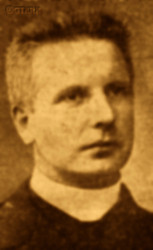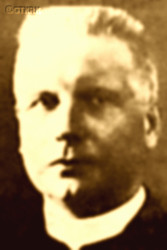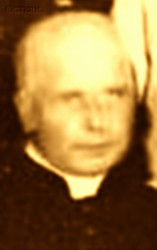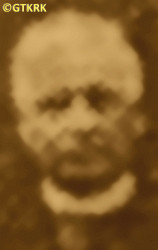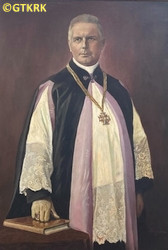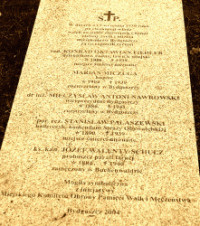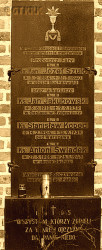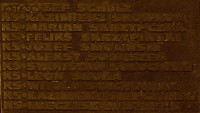Roman Catholic
St Sigismund parish
05-507 Słomczyn
85 Wiślana Str.
Konstancin deanery
Warsaw archdiocese, Poland
full list:
displayClick to display full list

searchClick to search full list by categories
wyświetlKliknij by wyświetlić pełną listę po polsku

szukajKliknij by przeszukać listę wg kategorii po polsku

Martyrology of the clergy — Poland
XX century (1914 – 1989)
personal data
surname
SCHULZ
surname
versions/aliases
SZULC
forename(s)
Joseph Valentine (pl. Józef Walenty)
function
diocesan priest
creed
Latin (Roman Catholic) Church RCmore on
en.wikipedia.org
[access: 2014.09.21]
diocese / province
Gniezno and Poznań archdiocese (aeque principaliter)more on
www.archpoznan.pl
[access: 2012.11.23]
RC Military Ordinariate of Polandmore on
en.wikipedia.org
[access: 2014.12.20]
honorary titles
honorary canonmore on
en.wikipedia.org
[access: 2014.11.14]
(1925, Our Lady of Perpetual Help, St Mary Magdalene and St Stanislav the Bishop and Martyr RC collegiate church, Poznańtoday: Poznań city pov., Greater Poland voiv., Poland
more on
en.wikipedia.org
[access: 2021.07.18])
„Polonia Restituta” Cross — 5th Class, Knight'smore on
en.wikipedia.org
[access: 2019.04.16]
(11.11.1935)
Gold „Cross of Merit”more on
en.wikipedia.org
[access: 2019.04.16]
(11.11.1935)
date and place
of death
31.03.1940

KL Buchenwaldconcentration camp
today: n. Weimar, Weimar urban dist., Thuringia state, Germany
more on
en.wikipedia.org
[access: 2022.01.09]
alt. dates and places
of death
31.03.1940, 17.04.1940
details of death
During his secondary schooling till 1904 in Germ. Königliches Gymnasium (Eng. Royal Gymnasium) in Wągrowiec member of Polish clandestine self‐educational Thomas Zan Society.
In 1912 participant of the pre‐election campaign in the Germ. Kreis Schildberg (Eng. Ostrzeszów County), in the Prussian part of partitioned Poland, i.e. the Germ. Provinz Posen (Eng. Poznań Province), supporting Polish candidates to the Germ. Preußischer Landtag (Eng. Prussian National Parliament) — elections were held in 1913 — and to the Germ. Reichstag (Eng. Reich Parliament) of the German Empire — elections were held in 1912.
During Greater Poland Uprising of 1918‐1919 chaplain to the Polish insurgents.
After German invasion of Poland on 01.09.1939 (Russians invaded Poland 17 days later) and start of the World War II, on 03.09.1939 became a member of the city's Citizens' Committee in Bydgoszcz.
On the same day, German saboteurs began to fire at the retreating Polish army and Polish civilians — as a result of the Polish reaction in the clashes, later called by the German National Socialist propaganda „Bloody Sunday”, c. 365 people died, including c. 250 of German nationality.
The next day, on 04.09.1939, became the vice–chairman of the Polish Citizens' Guard.
After the German army entered Bydgoszcz on 05.09.1939 — the Polish army had left the city earlier — took part in the capitulation negotiations, and, persuaded by the Germans, signed a proclamation calling on the inhabitants to remain calm, lay down their arms and return to work: in return, the Germans promised the inhabitants personal freedom, security and preservation of property.
And immediately broke their promises — on 07.09.1939, was arrested by the Germans.
Interrogated by the newly appointed German mayor of the city — harassed and beaten.
Held in military barracks' IL Bromberg camp in Bydgoszcz.
On 21.09.1939 transported to KL Dachau concentration camp and from there on 26‐27.09.1939 to KL Buchenwald concentration camp.
There slaved in quarries and initially during harsh winter held under a tent with a single pled.
Finally murdered — starved to death in a solitary bunker where was forced to do the most difficult tasks.
Prob. poisoned or strangled.
According to death report, issued in KL Buchenwald, the „honest” otherwise German „medical doctors” and formalists — and at the same time, unrivaled fairy tale spinners — noted that Germ. „Der Pole Josef Schulz, geb. am 3.2.84 Kwasuty, eingel. am 27.9.39 über Dachau (Heckenschütze), ist heute um 6.30 Uhr an Herzschwäche bei Herzwassersucht verstorben” (Eng. „The Pole Josef Schulz, born on 3.2.84 Kwasuty, admitted on 27.9.39 to Dachau (as Germ. Heckenschütze, i.e. shooter from hiding), died today at 6.30 a.m. from heart failure due to dropsy”).
prisoner camp's numbers
237Click to display source page (KL BuchenwaldClick to display the description)
cause of death
murder
perpetrators
Germans
sites and events
KL BuchenwaldClick to display the description, KL DachauClick to display the description, IL BrombergClick to display the description, «Intelligenzaktion»Click to display the description, Reichsgau Danzig‐WestpreußenClick to display the description, Ribbentrop‐MolotovClick to display the description, Pius XI's encyclicalsClick to display the description, Greater Poland UprisingClick to display the description, Thomas Zan SocietiesClick to display the description
date and place
of birth
03.02.1884Birth certification on:
www.genealogiawarchiwach.pl
[access: 2025.09.08]

Kwasutytoday: hamlet of Miniszewo village, Janowiec Wielkopolski gm., Żnin pov., Kuyavia‐Pomerania voiv., Poland
more on
en.wikipedia.org
[access: 2021.12.18]
parents
SCHULZ Andrew
🞲 1840, ? — 🕆 ?, ?

DOMAGALSKA Victoria
🞲 16.01.1848, ? — 🕆 ?, ?
presbyter (holy orders)
ordination
09.02.1908

Gnieznotoday: Gniezno urban gm., Gniezno pov., Greater Poland voiv., Poland
more on
en.wikipedia.org
[access: 2021.12.18]
Assumption of the Blessed Virgin Mary RC archcathedral churchmore on
en.wikipedia.org
[access: 2025.03.14]
positions held
1931 – 1939
parish priest — Bydgoszcztoday: Bydgoszcz city pov., Kuyavia‐Pomerania voiv., Poland
more on
en.wikipedia.org
[access: 2021.06.20] ⋄ St Martin and St Nicholas the Bishops and Confessors RC parish (main parish) ⋄ Bydgoszcz‐citydeanery name
today: Bydgoszcz city pov., Kuyavia‐Pomerania voiv., Poland
more on
en.wikipedia.org
[access: 2021.06.20] RC deanery — also: prison chaplain; c. 1936‐1939 deanery notary; c. 1934‐1939 inspector of religion classes in elementary schools for city of Bydgoszcz / Bydgoszcz deanery; member of the Diocesan Council of Catholic Action; member and from 1935 secretary of the Charles Marcinkowski Scientific Assistance Committee in Bydgoszcz
1917 – 1931
General secretary — Poznańtoday: Poznań city pov., Greater Poland voiv., Poland
more on
en.wikipedia.org
[access: 2021.07.18] ⋄ Union of Young Polish Women's Associations (1919‐1924 / from 1924 Young Polish Women Union) — organizer and founder on 21.09.1919 — led to an increase in the number of member associations from 50 in 1919 to 477 in 1931 of parish organizations; also: 1917‐1924 director of the Union of Working Women's Societies, from which the Union of Young Polish Women's Associations emerged; editor of Pl. „Gazety dla Kobiet” (Eng. „Newspaper for Women”); from 1924 of the Pl. „Doniesienia Związku Młodych Polek” (Eng. „Reports from the Young Polish Women's Association”) magazine; from 1927 member of the board of trustees of the Catholic Social School in Poznań; from 1918 member of the Union of „Caritas” Charity Societies
1917 – 1931
resident — Poznańtoday: Poznań city pov., Greater Poland voiv., Poland
more on
en.wikipedia.org
[access: 2021.07.18] ⋄ St Adalbert the Bishop and Martyr RC parish ⋄ Poznańtoday: Poznań city pov., Greater Poland voiv., Poland
more on
en.wikipedia.org
[access: 2021.07.18] RC deanery — prob. with a break for ministry in Kościan
1925 – 1927
curatus/rector/expositus — Kościantoday: Kościan gm., Kościan pov., Greater Poland voiv., Poland
more on
en.wikipedia.org
[access: 2021.07.18] ⋄ Holy Spirit RC church ⋄ Blessed Virgin Mary of the Assumption RC parish ⋄ Kościantoday: Kościan gm., Kościan pov., Greater Poland voiv., Poland
more on
en.wikipedia.org
[access: 2021.07.18] RC deanery
1919 – 1920
treasury officer / procurator — Poznańtoday: Poznań city pov., Greater Poland voiv., Poland
more on
en.wikipedia.org
[access: 2021.07.18] ⋄ Archbishop's Theological Seminary (Collegium Leoninum)
1914 – 1917
administrator — Myjomicetoday: Kępno gm., Kępno pov., Greater Poland voiv., Poland
more on
en.wikipedia.org
[access: 2021.12.18] ⋄ All the Saints RC parish ⋄ Kępnotoday: Kępno gm., Kępno pov., Greater Poland voiv., Poland
more on
en.wikipedia.org
[access: 2021.05.30] RC deanery — also: member of the People's Reading Rooms Society TCL in Kępno county
1910 – 1914
vicar — Ostrzeszówtoday: Ostrzeszów gm., Ostrzeszów pov., Greater Poland voiv., Poland
more on
en.wikipedia.org
[access: 2021.05.30] ⋄ Blessed Virgin Mary of the Assumption RC parish ⋄ Ostrzeszówtoday: Ostrzeszów gm., Ostrzeszów pov., Greater Poland voiv., Poland
more on
en.wikipedia.org
[access: 2021.05.30] RC deanery — also: member and later president of the People's Reading Rooms Society TCL in Ostrzeszów county
1909 – 1910
administrator — Śmieszkowoform.: Śmieszków
today: Sława gm., Wschowa pov., Lubusz voiv., Poland
more on
en.wikipedia.org
[access: 2021.07.18] ⋄ St Andrew the Apostle RC parish ⋄ Wschowatoday: Wschowa gm., Wschowa pov., Lubusz voiv., Poland
more on
en.wikipedia.org
[access: 2021.07.18] RC deanery
1909
vicar — Śmieszkowoform.: Śmieszków
today: Sława gm., Wschowa pov., Lubusz voiv., Poland
more on
en.wikipedia.org
[access: 2021.07.18] ⋄ St Andrew the Apostle RC parish ⋄ Wschowatoday: Wschowa gm., Wschowa pov., Lubusz voiv., Poland
more on
en.wikipedia.org
[access: 2021.07.18] RC deanery
1908 – 1909
vicar — Brennotoday: Wijewo gm., Leszno pov., Greater Poland voiv., Poland
more on
en.wikipedia.org
[access: 2022.01.10] ⋄ St Hedwig of Silesia RC parish ⋄ Wschowatoday: Wschowa gm., Wschowa pov., Lubusz voiv., Poland
more on
en.wikipedia.org
[access: 2021.07.18] RC deanery
1908
vicar — Otorowotoday: Szamotuły gm., Szamotuły pov., Greater Poland voiv., Poland
more on
en.wikipedia.org
[access: 2021.07.15] ⋄ All the Saints RC parish ⋄ Lwówektoday: Lwówek gm., Nowy Tomyśl pov., Greater Poland voiv., Poland
more on
en.wikipedia.org
[access: 2020.11.27] RC deanery
till 1908
student — Gnieznotoday: Gniezno urban gm., Gniezno pov., Greater Poland voiv., Poland
more on
en.wikipedia.org
[access: 2021.12.18] ⋄ philosophy and theology, Archbishop's Practical Theological Seminary (Lat. Seminarium Clericorum Practicum)
from 1904
student — Poznańtoday: Poznań city pov., Greater Poland voiv., Poland
more on
en.wikipedia.org
[access: 2021.07.18] ⋄ philosophy and theology, Archbishop's Theological Seminary (Collegium Leoninum)
others related
in death
BUKOWSKIClick to display biography Leopold, DOMERACKIClick to display biography Joseph Valentine, DRWALClick to display biography Francis, DRWĘSKIClick to display biography Stanislav Felix (Bro. Felician), GLAKOWSKIClick to display biography Stanislav, HANKEClick to display biography Francis, HAROŃSKIClick to display biography Leo Joseph, HUWERClick to display biography Joseph, KULISZClick to display biography Charles, KUPILASClick to display biography Francis, LANGNERClick to display biography Herbert, PANKOWSKIClick to display biography Marian, POLEDNIAClick to display biography Paul, ROGACZEWSKIClick to display biography Adalbert Theophilus, SEKRECKIClick to display biography Henry, STOCKClick to display biography Joseph
sites and events
descriptions
KL Buchenwald: In German Germ. Konzentrationslager (Eng. concentration camp) KL Buchenwald concentration camp, founded in 1937 and operational till 1945, Germans held c. 238,380 prisoners and murdered approx. 56,000 of them, among them thousands of Poles. Prisoners were victims of pseudo‐scientific experiments, conducted among others by Behring‐Werke from Marburg and Robert Koch Institute from Berlin companies. They slaved for Gustloff in Weimar and Fritz‐Sauckel companies manufacturing armaments. To support Erla‐Maschinenwerk GmbH in Leipzig, Junkers in Schönebeck (airplanes) and Rautal in Wernigerode Germans organized special sub‐camps. In 1945 there were more than 100 such sub‐camps. Dora concentration camp was initially one of them, as well as KL Ravensbrück sub‐camps (from 08.1944). On 08.04.1945 Polish prisoner, Mr Guido Damazyn, used clandestinely constructed short wave transmitter to sent, together with a Russian prisoner, a short message begging for help. It was received and he got a reply: „KZ Bu. Hold out. Rushing to your aid. Staff of Third Army” (American). Three days later the camp was liberated. (more on: www.buchenwald.deClick to attempt to display webpage
[access: 2013.08.10], en.wikipedia.orgClick to attempt to display webpage
[access: 2013.08.10])
KL Dachau: KL Dachau in German Bavaria, set up in 1933, became the main German Germ. Konzentrationslager (Eng. concentration camp) KL for Catholic priests and religious during World War II: On c. 09.11.1940, Reichsführer‐SS Heinrich Himmler, head of the SS, Gestapo and German police, as a result of the Vatican's intervention, decided to transfer all clergymen detained in various concentration camps to KL Dachau camp. The first major transports took place on 08.12.1940. In KL Dachau Germans held approx. 3,000 priests, including 1,800 Poles. The priests were forced to slave labor in the Germ. „Die Plantage” — the largest herb garden in Europe, managed by the genocidal SS, consisting of many greenhouses, laboratory buildings and arable land, where experiments with new natural medicines were conducted — for many hours, without breaks, without protective clothing, no food. They slaved in construction, e.g. of camp's crematorium. In the barracks ruled hunger, freezing cold in the winter and suffocating heat during the summer, especially acute in 1941‐1942. Prisoners suffered from bouts of illnesses, including tuberculosis. Many were victims of murderous „medical experiments” — in 11.1942 c. 20 were given phlegmon injections; in 07.1942 to 05.1944 c. 120 were used by for malaria experiments. More than 750 Polish clerics where murdered by the Germans, some brought to TA Hartheim euthanasia centre set up in Schloss Hartheim in Austria and murdered in gas chambers. At its peak KL Dachau concentration camps’ system had nearly 100 slave labour sub‐camps located throughout southern Germany and Austria. There were c. 32,000 documented deaths at the camp, and thousands perished without a trace. C. 10,000 of the 30,000 inmates were found sick at the time of liberation, on 29.04.1945, by the USA troops… (more on: www.kz-gedenkstaette-dachau.deClick to attempt to display webpage
[access: 2013.08.10], en.wikipedia.orgClick to attempt to display webpage
[access: 2016.05.30])
IL Bromberg: Germ. „Internierungslager” (Eng. „Internment camp”) set up on 05.09.1939 — the day Germans took over Bydgoszcz — in 15 Greater Poland Light Artillery Regiment military barracks at 147 Gdańska Str. in Bydgoszcz. In 09.1939 only c. 3,500 Poles were jailed there. Prisoners were held in f. stables or f. armory building. They were maltreated and tortured. Some were shot on the spot (c. 28 victims in 09.1939). Next they were sent to concentration camps throughout Germany. Some were taken to mass execution sites in nearby forests and murdered. On 01.11.1939 the camp was moved to f. ammunition warehouses in Jachcice town district. The camp was closed in 12.1939. (more on: pl.wikipedia.orgClick to attempt to display webpage
[access: 2015.09.30])
«Intelligenzaktion»: German: «Intelligenzaktion» (English: „Intelligence Action”) — a German program of extermination of the Polish elite, mainly the intelligentsia and leadership layers, carried out from the beginning of the occupation in w 09.1939 to 04.1940, mainly in territories directly annexed to Germany, but also in the so‐called Germ. Generalgouvernement (Eng. General Governorate), where it was called «AB‐aktion». In the first phase, immediately after the beginning of the German occupation, during military operations carried out by the Germ. Wehrmacht (Eng. Armed Forces) and the genocidal units of the Germ. Einsatzgruppen (Eng. Operational Groups) of the Germ. Sicherheitspolizei (Eng. Security Police), i.e. SiPo, and Germ. Sicherheitsdienst des Reichsführers SS (Eng. Security Service of the Reichsführer SS), i.e. SD, organized by the Germ. Reichssicherheitshauptamt (Eng. Reich Main Security Office), i.e. RSHA, which followed the troops, carried out under the Germ. Unternehmen „Tannenberg” (Eng. Operation „Tannenberg”) — based on the so‐called Germ. Sonderfahndungsliste (Eng. Special Wanted Lists), i.e. proscription lists of Poles considered particularly dangerous to the Third Reich, prepared by the Zentralstelle II/P (Polen) unit of the German RSHA. Later, implemented by the German civilian occupation authorities and the genocidal unit of the Germ. Volksdeutscher Selbstschutz (Eng. Ethnic Germans Self‐Defense), whose members were Germ. Volksdeutsche (Eng. Ethnic Germans), i.e. representatives of the German minority in Poland. According to various sources, these lists, at the beginning of 09.1939, could have contained the details of 61,000—88,000 „dangerous” Poles — although these figures cannot be confirmed. In total, during this genocide, c. 50,000 teachers, Catholic priests, representatives of the landed gentry, freelancers, social and political activists, and retired military personnel were systematically and methodically murdered. Another 50,000 were sent to concentration camps, where only a negligible percentage survived. (more on: en.wikipedia.orgClick to attempt to display webpage
[access: 2014.10.04])
Reichsgau Danzig‐Westpreußen: After the Polish defeat in the 09.1939 campaign, which was the result of the Ribbentrop‐Molotov Pact and constituted the first stage of World War II, and the beginning of German occupation in part of Poland (in the other, eastern part of Poland, the Russian occupation began), the Germans divided the occupied Polish territory into five main regions (and a few smaller). The largest one was transformed into Germ. Generalgouvernement (Eng. General Governorate), intended exclusively for Poles and Jews and constituting part of the so‐called Germ. Großdeutschland (Eng. Greater Germany). Two were added to existing German provinces. From two other separate new provinces were created. Vistula Pomerania region was one of them, incorporated into Germany on 08.10.1939, by decree of the German leader Adolf Hitler (formally came into force on 26.10.1939), and on 02.11.1939 transformed into the Germ. Reichsgau Danzig‐Westpreußen (Eng. Reich District of Gdańsk‐West Prussia) province, in which the law of the German state was to apply. The main axis of the policy of the new province, the territory of which the Germans recognized as the Germ. „Ursprünglich Deutsche” (Eng. „natively German”), despite the fact that 85% of its inhabitants were Poles, was Germ. „Entpolonisierung” (Eng. „Depolonisation”), i.e. forced Germanization. C. 60,000 Poles were murdered in 1939‐1940, as part of the Germ. „Intelligenzaktion”, i.e. extermination of Polish intelligentsia and ruling classes, in c. 432 places of mass executions — including c. 220 Polish Catholic priests. The same number were sent to German concentration camps, from where few returned (over 300 priests were arrested, of whom c. 130 died in concentration camps). C. 124,000‐170,000 were displaced, including c. 90,000 to the Germ. Generalgouvernement. Poles were forced en masse to sign the German nationality list, the Germ. Deutsche Volksliste DVL. Polish children could only learn in German. It was forbidden to use the Polish language during Catholic Holy Masses and during confession. Polish landed estates were confiscated..To further reduce the number of the Polish population, Poles were sent to forced labor deep inside Germany. The remaining Poles were treated as low‐skilled labor, isolated from the Germans and strictly controlled — legally, three or three of them could only meet together, even in their own apartments. Many were conscripted into the German Wehrmacht army. After the end of hostilities of World War II, the overseer of this province, the Germ. Reichsstatthalter (Eng. Reich Governor) and the Germ. Gauleiter (Eng. district head) of the German National Socialist Party, Albert Maria Forster, was executed. (more on: en.wikipedia.orgClick to attempt to display webpage
[access: 2024.06.24])
Ribbentrop‐Molotov: Genocidal Russian‐German alliance pact between Russian leader Joseph Stalin and German leader Adolf Hitler signed on 23.08.1939 in Moscow by respective foreign ministers, Mr. Vyacheslav Molotov for Russia and Joachim von Ribbentrop for Germany. The pact sanctioned and was the direct cause of joint Russian and German invasion of Poland and the outbreak of the World War II in 09.1939. In a political sense, the pact was an attempt to restore the status quo ante before 1914, with one exception, namely the „commercial” exchange of the so‐called „Kingdom of Poland”, which in 1914 was part of the Russian Empire, fore Eastern Galicia (today's western Ukraine), in 1914 belonging to the Austro‐Hungarian Empire. Galicia, including Lviv, was to be taken over by the Russians, the „Kingdom of Poland” — under the name of the General Governorate — Germany. The resultant „war was one of the greatest calamities and dramas of humanity in history, for two atheistic and anti‐Christian ideologies — national and international socialism — rejected God and His fifth Decalogue commandment: Thou shall not kill!” (Abp Stanislav Gądecki, 01.09.2019). The decisions taken — backed up by the betrayal of the formal allies of Poland, France and Germany, which on 12.09.1939, at a joint conference in Abbeville, decided not to provide aid to attacked Poland and not to take military action against Germany (a clear breach of treaty obligations with Poland) — were on 28.09.1939 slightly altered and made more precise when a treaty on „German‐Russian boundaries and friendship” was agreed by the same murderous signatories. One of its findings was establishment of spheres of influence in Central and Eastern Europe and in consequence IV partition of Poland. In one of its secret annexes agreed, that: „the Signatories will not tolerate on its respective territories any Polish propaganda that affects the territory of the other Side. On their respective territories they will suppress all such propaganda and inform each other of the measures taken to accomplish it”. The agreements resulted in a series of meeting between two genocidal organization representing both sides — German Gestapo and Russian NKVD when coordination of efforts to exterminate Polish intelligentsia and Polish leading classes (in Germany called «Intelligenzaktion», in Russia took the form of Katyń massacres) where discussed. Resulted in deaths of hundreds of thousands of Polish intelligentsia, including thousands of priests presented here, and tens of millions of ordinary people,. The results of this Russian‐German pact lasted till 1989 and are still in evidence even today. (more on: en.wikipedia.orgClick to attempt to display webpage
[access: 2015.09.30])
Pius XI's encyclicals: Facing the creation of two totalitarian systems in Europe, which seemed to compete with each other, though there were more similarities than contradictions between them, Pope Pius XI issued in 03.1937 (within 5 days) two encyclicals. In the „Mit brennender Sorge” (Eng. „With Burning Concern”) published on 14.03.1938, condemned the national socialism prevailing in Germany. The Pope wrote: „Whoever, following the old Germanic‐pre‐Christian beliefs, puts various impersonal fate in the place of a personal God, denies the wisdom of God and Providence […], whoever exalts earthly values: race or nation, or state, or state system, representatives of state power or other fundamental values of human society, […] and makes them the highest standard of all values, including religious ones, and idolizes them, this one […] is far from true faith in God and from a worldview corresponding to such faith”. On 19.03.1937, published „Divini Redemptoris” (Eng. „Divine Redeemer”), in which criticized Russian communism, dialectical materialism and the class struggle theory. The Pope wrote: „Communism deprives man of freedom, and therefore the spiritual basis of all life norms. It deprives the human person of all his dignity and any moral support with which he could resist the onslaught of blind passions […] This is the new gospel that Bolshevik and godless communism preaches as a message of salvation and redemption of humanity”… Pius XI demanded that the established human law be subjected to the natural law of God , recommended the implementation of the ideal of a Christian state and society, and called on Catholics to resist. Two years later, National Socialist Germany and Communist Russia came together and started World War II. (more on: www.vatican.vaClick to attempt to display webpage
[access: 2023.05.28], www.vatican.vaClick to attempt to display webpage
[access: 2023.05.28])
Greater Poland Uprising: Military insurrection of Poles of former German Germ. Posen Provinz (Eng. Poznań province) launched against German Reich in 1918‐1919 — after the abdication on 09.11.1918 of the German Emperor William II Hohenzollern; after the armistice between the Allies and Germany signed on 11.1.1918 in the HQ wagon in Compiègne, the headquarters of Marshal of France Ferdinand Foch — which de facto meant the end of World War I — against the German Weimar Republic, established on the ruins of the German Empire, aiming to incorporate lands captured by Prussia during partitions of Poland in XVIII century into Poland. The Republic of Poland, reborn on 11.11.1918, initially formally included only the so‐called Germ. Königreich Polen (Eng. Kingdom of Poland), i.e. the territory that had been under Russian rule until 1915 and then under the control of Central States (Germany and Austria–Hungary), but did not include the Prussian partition. Started on 27.12.1918 in Poznań and ended on 16.02.1919 with the armistice pact in Trier, forced by the victorious Entente states, which included provisions ordering Germany to cease operations against Poland and, importantly, recognizing the Polish insurgent Greater Poland Army as an allied armed force of the Entente. De facto it turned out to be a Polish victory, confirmed in the main peace treaty after World War I, the Treaty of Versailles of 28.06.1919, which came into force on 10.01.1920 and in which most of the lands of the Prussian partition were recognized as Polish. Many Polish priests took part in the Uprising, both as chaplains of the insurgents units and members and leaders of the Polish agencies and councils set up in the areas covered by the Uprising. In 1939 after German invasion of Poland and start of the World War II those priests were particularly persecuted by the Germans and majority of them were murdered. (more on: en.wikipedia.orgClick to attempt to display webpage
[access: 2016.08.14])
Thomas Zan Societies: Secret societies of Polish youth, aiming at self‐education, patriotic in form and content, functioning 1830‐1920, in mutiny against enforced Germanisation and censure of Polish culture, mainly in secondary schools — gymnasia — mainly in Greater Poland (Wielkopolska) and later in Silesia. The first groups were formed in 1817. In 1897 a congress in Bydgoszcz was held when rules of clandestine activities were formulated. At other congress in Bydgoszcz in Poznań a „Red Rose” society was formed, heading all others groups in various gymnasiums and coordinating their activities. In 1900 „Red Rose” consolidated Philomaths organizations from Pomerania as well. After Toruń trial of Pomeranian Philomaths in Toruń Germans arrested 24 members of Thomas Zan Society from Gniezno. 21 of them were sentenced up to 6 weeks in prison and reprimands. All were relegated from schools without the right to continue education in secondary and higher schools in Prussia. Despite repression the Societies existed till 1918 and rebirth of Poland. (more on: pl.wikipedia.orgClick to attempt to display webpage
[access: 2021.12.19])
sources
personal:
www.wtg-gniazdo.orgClick to attempt to display webpage
[access: 2012.11.23], pl.wikipedia.orgClick to attempt to display webpage
[access: 2013.08.10], www.genealogiawarchiwach.plClick to attempt to display webpage
[access: 2025.09.08], www.archiwum.archidiecezja.plClick to attempt to display webpage
[access: 2013.08.10]
bibliographical:
„Martyrology of the Polish Roman Catholic clergy under nazi occupation in 1939‐1945”, Victor Jacewicz, John Woś, vol. I‐V, Warsaw Theological Academy, 1977‐1981
„Social Activist Priests in Greater Poland”, collective work, Biographical Dictionary, vol. 3 P‐S, Gniezno 2008
„International Tracing Service (ITS), Bad Arolsen, GermanyClick to display source page”, Arolsen Archives
original images:
www.wtg-gniazdo.orgClick to attempt to display webpage
[access: 2012.11.23], www.przewodnik-katolicki.plClick to attempt to display webpage
[access: 2015.09.30], www.pomorska.plClick to attempt to display webpage
[access: 2015.09.30], kpbc.umk.plClick to attempt to display webpage
[access: 2021.05.20], izbameczennikow.plClick to attempt to display webpage
[access: 2024.12.13], www.cmentarze.bydgoszcz.plClick to attempt to display webpage
[access: 2014.01.06], commons.wikimedia.orgClick to attempt to display webpage
[access: 2014.01.06]
LETTER to CUSTODIAN/ADMINISTRATOR
If you have an Email client on your communicator/computer — such as Mozilla Thunderbird, Windows Mail or Microsoft Outlook, described at WikipediaPatrz:
en.wikipedia.org, among others — try the link below, please:
LETTER to CUSTODIAN/ADMINISTRATORClick and try to call your own Email client
If however you do not run such a client or the above link is not active please send an email to the Custodian/Administrator using your account — in your customary email/correspondence engine — at the following address:

giving the following as the subject:
MARTYROLOGY: SCHULZ Joseph Valentine
To return to the biography press below:
 Click to return to biography
Click to return to biography








